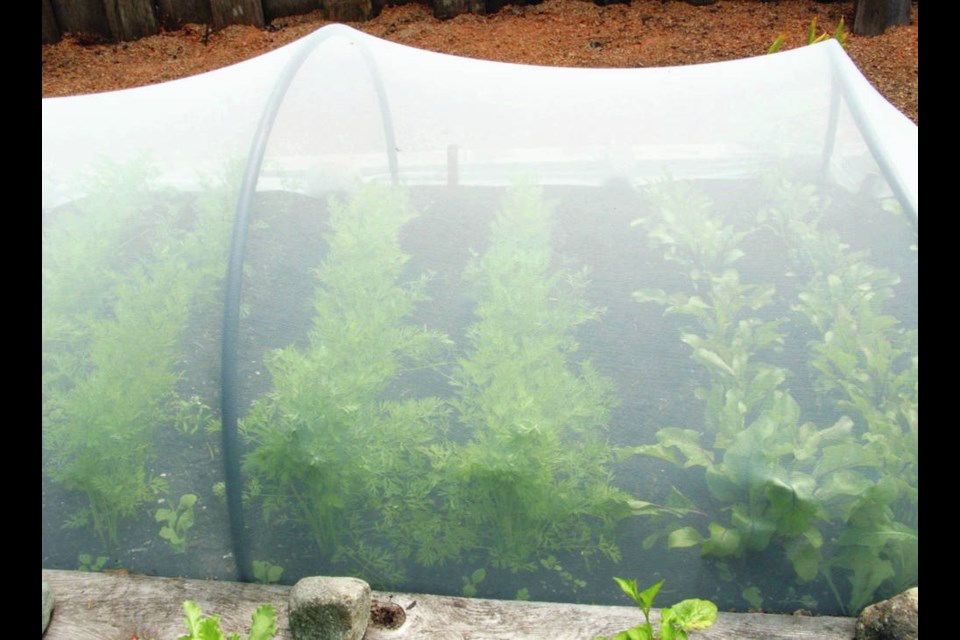Dear Helen: A few months ago you suggested using row cover over carrots to protect them from carrot fly. Does the carrot fly hang around all summer, or is it safe to remove the row cover now?
S.B.
Please leave the cover over your carrots, and make sure the edges are secured well into the soil around the planting. Though the first wave of the egg-laying flies is usually the heaviest and most damaging, a series of further generations follow through the summer and even, if the weather stays warm, into early autumn.
Adult flies first begin emerging around mid-April. The eggs they lay beside carrot plants hatch into the maggots that feed on the roots. After a few weeks of feeding the maggots pupate, to produce another generation in June. The pattern continues with more flies emerging to lay eggs from mid-summer into the fall.
Because carrot fly populations have been heavy in my area, I keep my carrots covered from seeding through to frost, when the tops die down. At that point I mulch over the roots with soil or/and leaves, and mark the planting with stakes at the four corners as guides to digging the roots through the winter.
Dear Helen: When should I start the seeds indoors for an autumn harvest of snow and snap peas?
E.W.
Depending on the variety, snow and snap peas can begin producing harvestable pods from 55 to 70 days from seeding. Catalogue listings and seed packets note the number of days to maturity, but for peas the number indicates days from a direct sowing into a garden space. That’s the usual method for planting peas. Direct seeding mid-July to early August should work for an autumn harvest.
An advantage to starting snap and snow peas indoors in summer is that the seeds don’t germinate well in high temperatures — unless there is a cool site for them, where the soil can easily be kept moist.
Transplants set out as the weather begins cooling in August often do well. For this purpose, an indoor sowing in the second or third week in July should work.
You might consider trying both methods, to see which one works better in your garden’s conditions.
Dear Helen: A friend has given me a few bigroot geranium plants. You have written about how they will form a low-growing, weed-suppressing mat of plants with late spring and early summer flowers. My question: How close should I place the plants together for them to form a solid mat?
G.K.
That depends on the soil conditions and your patience. In a moist, humus-rich soil, the plants will take hold and begin expanding to fill spaces between them fairly quickly. In leaner soils, that process can take longer.
The last time I set out a few plants (taken from established plantings) I set them about 25 cm apart. This was last summer, in a difficult site with lean soil and some root competition from the neighbours’ trees. Small offshoot plants have begun to fill in some of the spaces between them.
Should you choose a close spacing, and the mat of plants becomes congested, simply pull some up singly, to thin the planting, and set the thinnings in other spots in the garden.
Bigroot geranium (Geranium macrorrhizum) is a tough, grow-anywhere ground cover, but like other drought tolerant plants they need watering while they establish root systems, through the summer and early autumn in dry weather.
Dear Helen: Is there any way to prevent the white powdery mildew that appears on zucchini plants later in the summer?
S.L.
I’ve found that a generous mulching with a rich compost helps to keep the plants vibrant and producing well for as long as possible, but we cannot stop the late summer’s cooling temperatures and increasing humidity that foster the development of powdery mildew on the old foliage of zucchini planted in spring.
Because young zucchini foliage is more resistant to the fungus, I seed zucchini again in early July for transplanting late in July and harvesting through late summer and early autumn.
VHS meeting. The Victoria Horticultural Society is hosting a Zoom meeting on Tuesday, July 6, from 7 to 8:30 p.m. Loree Bohl, author of Fearless Gardening (Timber Press), will speak about Hardy Plant Choices and Fool-the-Eye Alternatives. Non-members can register for $5.00. To register visit vichortsociety.org.



